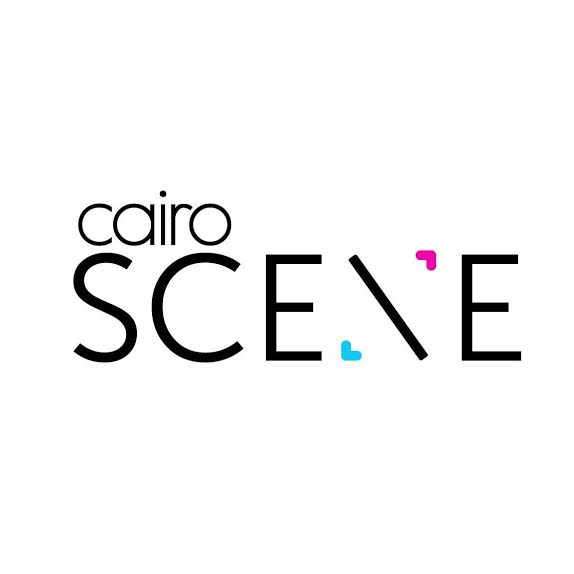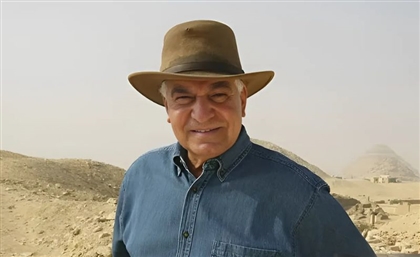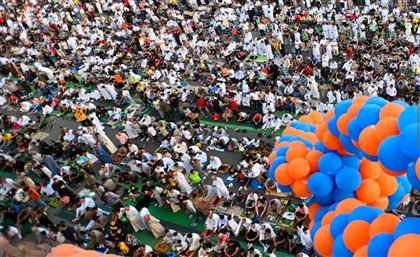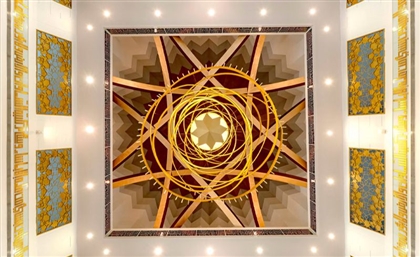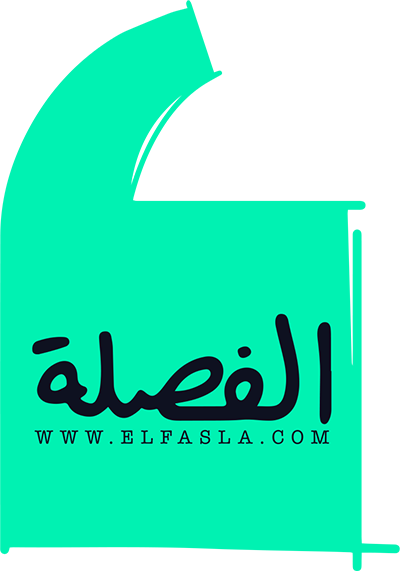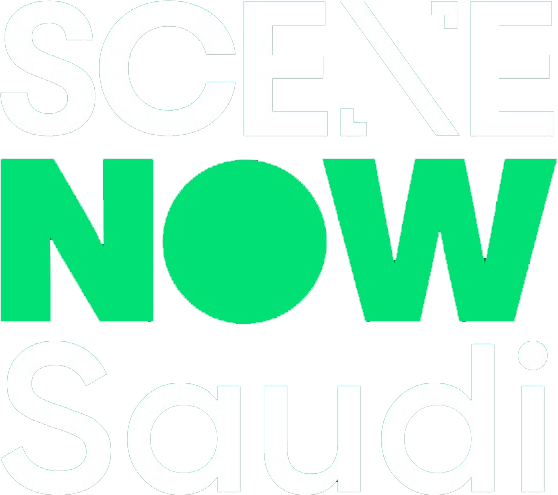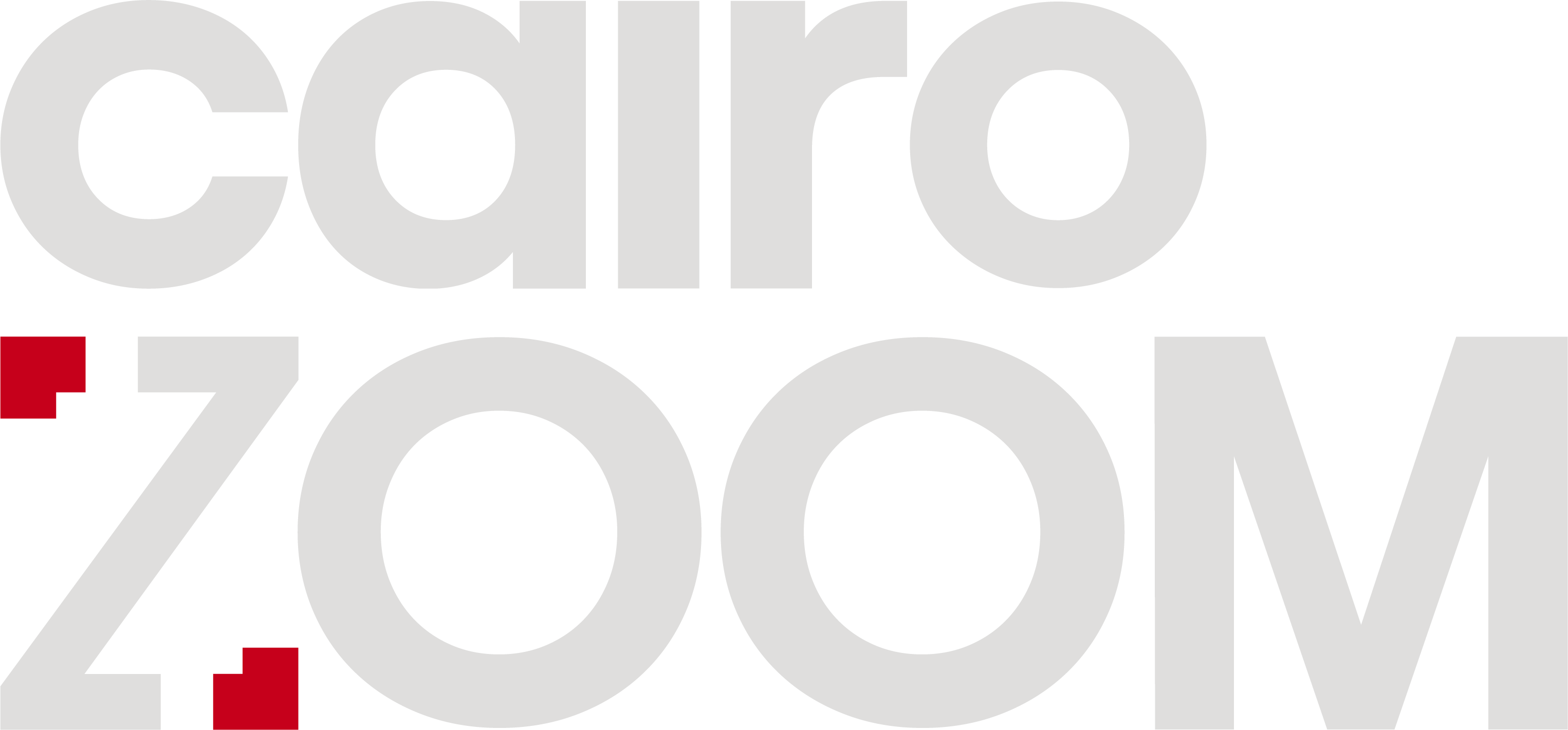Transform Today: Sabry Marouf
We're back with the latest inspiring interview in collaboration with Absolut to shine a spotlight on jewellery design duo Ahmed Sabry and Daki Marouf to find out how they shed the shackles of corporate life and ran free with their avant-garde looks.
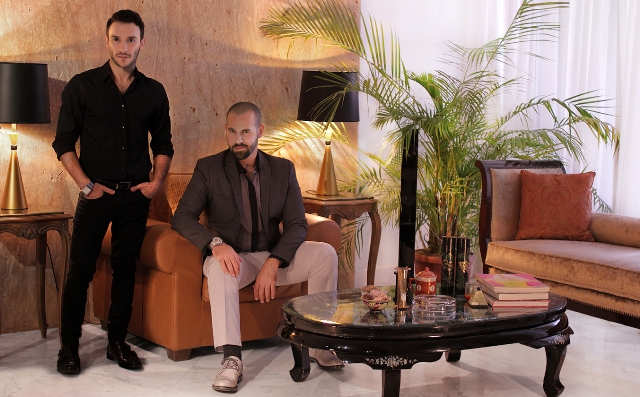
The latest in our series of inspiring interviews with local talents as part of the Transform Today campaign by Absolut, we speak to Ahmed Sabry (left) and Daki Marouf (right) of Cairo-based international avant-garde jewellery brand, Sabry Marouf. Both previously locked up in their respective occupations of marketing and architecture, the duo stemmed off to eventually create Egypt's most innovative accessory line. In a city where ‘jewellery designer’ was often taken to mean fresh-grad pseudo-fashionistas with daddy's money, a lot of time and 'Kaf' pendants, the duo set out to change the industry with their stunning collections in heavy metals that play on the idiosyncrasies of both Egypt's past and future. They exude a symbiosis as a team, with equal parts artistic expression and business savvy, and their work has culminated in their most recent collection: ISIS; an amalgamation of Pharaonic symbols in tune with the era of the Egyptian Goddess, brought into the present. We speak to the designer duo about their creative philosophies and transformational journey...

Was there a specific moment when you decided to leave marketing and architecture, respectively, and concentrate on jewellery designs?
Marouf: Not that I remember - it all sort of happened organically. Pre-Sabry Marouf I had been working in design and project management with a high-end luxury interiors firm and it gave me immense exposure to the regional luxury and retail industries. It really presented itself and totally became apparent that the fashion landscape was where I needed to cross over into. I explored that with Sabry and saw the void in the Middle Eastern markets for artifacts that truly speak of our heritage through a contemporary language. Something seriously needed to be disrupted! Simultaneously, with the advent of social networking and popular culture, the region was suddenly very interested in fashion. So I suppose that, more than anything, it was entrepreneurial instinct that led me to transform.
Sabry: I went into advertising and marketing knowing I would eventually one day shift my focus onto having my own business in the creative industry, I never could take working for somebody else’s vision for long. I was just waiting for the right time. While still working in advertising, Marouf and I were planning the brand back in 2009. We realised we both needed to focus our complete attention to the brand, and that’s when we started to clear our palettes for Sabry Marouf.
Do you think it's possible to balance the two? Is an entire transformation necessary to live through your art?
Marouf: ‘Absolutely’ impossible! I had to dedicate myself entirely to the brand before anything could really materialise. Multitasking is an inefficient notion and doesn’t yield the results that would otherwise be possible through dedication to one goal at a time. A successful transformation implies a complete change of state, which means if one were to attempt the balancing act, he or she will eventually lose balance and fall – defeating the purpose.
Sabry: I don’t think balancing really works, at least not for me, plus it won’t really be a transformation, it’ll be confusing. You’ll be torn. You already have to juggle several things in any creative job; I get a lot of new creative ideas, we have to filter those, then we have to further develop our selections, while managing existing production lines and quality control, as well as taking on select bespoke projects, while you also have to work on expanding and promoting - and this is when things are going well! We are only a small but strong team, so obviously I’d be quite foolish to try and run Sabry Marouf creatively and do some other endeavour at the same time. I’d imagine it’d only be stressful to always be between things – So, yes, entire transformation necessary.

Has the time spent at your previous occupations benefited what you do now, or do you regret not getting starting Sabry Marouf sooner?
Sabry: Regret is kind of toxic, and so I try not to harbour these kinds of emotions. However, I strongly believe everything happens for a reason; every choice and decision leads to the next experience and shapes the experience as it happens, and you keep transforming along the way, at your own will and through your own choices and decisions. Every professional experience I went through helped me with my responsibilities as creative director of Sabry Marouf. Majoring in history back in high school brought me up to pace on ancient Egyptian history and then studying advertising, marketing and graphic design helped a lot. And working in corporate branding helped with communicating our brand ethos effectively as well. It’s really ongoing, even projects we take on now affect how I think of what we do next.
Marouf: Coming from a design and engineering background was helpful. We would not do what we do today without doing what we did yesterday. The creative processes we go through for a piece of jewellery are almost identical to that of coming up with the form of a building or structure. I view architecture and fashion accessories as very similar – with differences in scale and utility, of course. I like to think of what we do now as ‘Intimate Architecture.’
How did you both get into the world of fashion and jewellery, is it something you’ve always been into?
Marouf: I’ve always been intrigued by fashion, design and luxury. For me it was a natural evolution of something I knew I would become. And in general, I got fed up facilitating somebody else’s vision. I knew Sabry and I had something very authentic, and totally distinguished from what was already out there. And on the onset of it, we knew how cut-throat of an industry it is, globally. But fashion is a trillion dollar marketplace, finally beginning to take of in the Middle East, and begging to be disrupted!
Sabry: Well, I’ve always been into artistic expression. I sketched a lot through my teenage years, also fashion is so intriguing as a contemporary communication tool, and I paid lots of attention to it growing up. But I didn’t always know I would work in fashion and jewellery, just that I would be a designer and use my design skills. Metalwork and silversmithing as forms of expression were my instinct and I immersed myself in the workshops of old Cairo. And I am blessed for all my experiences.
What are the biggest challenges you faced during your transformation? How did your family take the change?
Sabry: Getting used to overlooking everything in the daunting production process was hard as I didn’t have a lot of experience in that. To make sure our vision is translated through the pieces and ultimately the formulation and collections is a tough process. It’s a very competitive industry, which has led me to challenge myself and always delivering the best possible outcomes. I’m very lucky to have Marouf manage both the company and the brand, because fashion really means business. My family has always been supportive of my rational decisions, thank God for them. Also, it was not really a sudden change to them at all; I was designing for a long time before I decided to start a business revolving around design.
Marouf: The process of transformation in itself was the challenge. I had to get to know myself better, and step outside of the comfort zone of just doing what you know how to do. In a sense, I had to ‘let go’ before I can become. It took quite a bit of soul searching, determination and a certain degree of being shrewd. I really had to prove myself to my own self that it is the right choice. My family was initially confused but has been supportive nonetheless, and I feel blessed for that. You just have to follow your instinct and avoid viewing potentiality as a nuisance.

What are your artistic inspirations and what drives you most to create?
Marouf: Our driving force is innovation. We try to immerse people into our world through our work. It’s a philosophical, fantastical world spread across time, one of dualities; glamorous yet sober, spiritual yet material, seen vs. unseen. We like to deconstruct, experiment, invent with no pretense.
Sabry: Obviously our ancient Egyptian heritage from innovative new angles, and a lot of their philosophies and world views. I’m very inspired by their obsession with perfection and control on all levels, also spirituality and the afterworlds really inspire me. I like to create artifacts that have deeper hidden meanings to them. Inspiring individuals sometimes influence me to create too.
You’re designs are embedded in Egyptian heritage; how important do you feel it is to relate concept to your environment?
Marouf: We are proud of our Egyptian roots. The Pharaohs were always and continue to be an enigma that captivates the world. Their perception of life was so in tune with the beyond, where spirituality was a way of life rather than a compartment. There is a lot to be learned from the ancient Egyptians, whether from their art, connections with the unknown, or way of life. The depth and meaning they attach to everything is very admirable to us, not to mention how progressive they were in their own fashion. Jewellery and artifacts were very important to them—it symbolised their myths and beliefs, and put through associations relating to the wearer. In a way it was a materialisation of what they believed in—a very sober and beautiful way of doing things. This, we respect. While relating to your context is important, I believe that relating to what you believe in, is far more important.
Sabry: It is very important for an artist to express something of substance and relevance to them personally, whether it relates to direct environment or something that influences their life. I think that is the message of an artist. It translates into genuine work of artistic value. It must be authentic and conveys a unique message. Imitating, copying success stories, or just baking hot cakes for more money is a losing bet for any artist or designer. And what moves us to create is mainly the very enigmatic multifaceted Egyptian heritage.
As far as avant-garde designers go in Egypt, they’re few and far between and the general trend remains in traditional styles of gold jewellery. Do you feel like your creativity is stifled by an Egyptian audience? Or does it challenge you to push the limits?
Marouf: The prevailing designers and their products are a mere reflection of the market’s demands. And that’s OK since our brand operates within a niche and our target is a very specific consumer, whether in Egypt or beyond. I don’t believe that we are in any way stifled and on the contrary, we have been well received and the Sabry Marouf woman has always managed to identify with us.
Sabry: Well, we aren’t just designing for Egyptians! We cater to an international clientele. I really don’t think that the trends are still focusing on just traditional; even the fine jewellery brands create more exciting pieces now. Extremes are being normalised now, in a way. We know our customers and they know us, and this is part of the Sabry Marouf experience, we’re a private brand which differentiates itself with its one-of-a kind fashion artifacts.
Made from one source, and distilled and bottled in the same place, Absolut is known for its quality and originality. What is the design and manufacturing process like for Sabry Marouf?
Sabry: The design process is beautiful, it’s a state of creative bliss for me and I really quite enjoy it. It starts with inspiration, naturally! If it’s something captivating enough we discuss the way it would translate into an encompassing concept for a collection. Then the most fun part, the fantasy and endless possibility of what we could create - we envision it all, the pieces, the execution the presentation, the character, the face of the collection everything and this normally takes time, then it’s edit, edit, edit until we think we’ve reached something good. Then we go into the much less exciting part of the process, manufacturing and quality control. It’s back to earth and facing the realities of applying your fantasies. Quite stressful at times!
Marouf: We place an emphasis on design development, and thinking why it is that we are putting this particular piece into the world. And then whole creative process has to translate into value, so we do give design and development lots of TLC. All workmanship is carried out by our bench-jewelers in our workshop in the heart of historic Fatimid Cairo, a jewellery district and crafts hub that has been producing all kinds of art for centuries. We employ several metals because it depends on the brief; brass for our accessories and directional collections, gold and silver for limited editions as well as our bespoke projects.

Jewellery is usually perceived as an extra, more frivolous accessory to an outfit. Does this motivate you to create more eye-catching designs?
Marouf: (Laughs) To me, fashion accessories actually complete an outfit; otherwise it would only be clothing.
Sabry: Not really, I don’t design with the object of being flashy or ‘out there’ for the sake of it! Our more directional pieces do tend to catch the attention of the press or whatever, and that is good for everyone but it isn’t particularly the motive.
On the flip side of that, the term ‘statement jewellery’ is often used; do you think fashion has to make a statement?
Sabry: Anybody doing anything now wants to make a statement, so naturally fashion these days is always on the lookout for a statement. Otherwise, you’re not really doing anything new.
Marouf: I’m weary of using the term ‘statement’ because it implies a certain false pretense. As an industry, fashion has to constantly present newness. The simple facts are dictated by current organisational structure consumers which has shown us that only 2% of the population constitute the trend-setters – those who are not afraid to endorse innovations in the fashion cycle, leaving the majority of people, 98%, catching onto the statement by the time it has gone mainstream and really is no longer a ‘statement’, served by the high street retailers which we all know too well. This ensures that ‘life’ goes on in many senses; there is a ‘trickling’ down process which occurs, ensuring that everybody from the bold and experimental to the timid and conservative are all catered to at their own pace of accepting change.
How are the wearers of Sabry Marouf transformed?
Marouf: Ultimately, I’d love to know how the Sabry Marouf woman (or man) would respond to that question. But I do believe they are transformed by the decision to buy into a brand that sets itself apart from the mainstream and celebrates our ancient Egyptian heritage in a contemporary way.
Sabry: I’m not sure if that happens to everyone. I’d love to think that they experience something wearing Sabry Marouf, that’s sometimes the purpose. I think working with Bosaina [our muse] was a transformation, it was certainly suggested in her performance. You can ask her, she did transform for ISIS.

A lot of your fashion is geared towards women; how are you transforming men’s outlook on accessorising?
Marouf: We do have a small men’s collection of cufflinks, metal-ties and bowties, and we’re always on the cusp of something new.
Sabry: Men, now more than ever, are accessorising and we will always be there to cater to this demand.
How do you free your mind when you're having a mental block?
Marouf: It depends on the intensity of the block. I find that music really tunes me out of most creative funks. But if it’s one these bad days and it’s just not possible to get on a creative frequency, you just have to let it be and wake up the next day with a new outlook.
Sabry: Sometimes you can’t force the creativity, you might need to detach at times. I stop working and do something else for a bit. If I have absolutely must work on design for a deadline or something, then some bonding with nature and the right kind of music, depending on the project, usually does the trick.
Which collection do you think really describes you as designers?
Marouf: ISIS. It is a collection of synthesis between past and future in that it attempts to subvert the stereotypical image of the mythical muse that is Isis. We chose to focus on Isis as the patron of nature and magic, more specifically exploring the enchantress side to her persona. This mystical aspect of her is what really inspired us in designing the collection, imagining her own world and the artifacts she is clad in.
Sabry: I would say ISIS, since it’s the latest, and we put so much thought and effort into it, it literally left me drained. The collection had a very strong concept behind it with a lot of striking pieces. It also got more attention than the previous two collections we did. We really put immense effort in creating something captivating presenting it to the public by collaborating with Bosaina on the launch.
The future is yours to create. Where do you see the brand going?
Marouf: It is what I want to be most known for; building SabryMarouf into an internationally recognised fashion enterprise rooted in Egypt.
Sabry: Regarding work, I would like to grow obviously, expand operations internationally and go into more interdisciplinary areas.
Where does Sabry Marouf retail?
Check out more from Sabry Marouf on their fanpage here. Stay tuned to CairoScene for more inspiring Transform Today stories by Absolut.
- Previous Article Abou-Treika Refuses Pope's Match for Peace
- Next Article Fabulously Flash
Trending This Week
-
Mar 29, 2025



